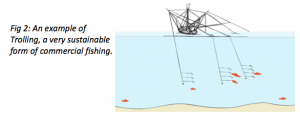Raise your hand if you like eating fish! Many of you probably raised your hand as fish is something that tastes delicious and can be very healthy for you. But is the fish that you are eating harvested in a way that’s healthy for the ocean? It’s hard to know for sure. There are many commercial fisheries that gather fish in a sustainable way. However, there are fishing methods that are destructive to the environment and result in lots of bycatch and habitat destruction. Today we are going to talk about some common commercial fishing methods, some that are sustainable and some that are very disruptive to the marine environment.
First off let’s cover what bycatch is. Bycatch is the term for catching a species of marine animal that you were not intending to catch such as a seabird, turtle, shark, or dolphin. There is an estimated 160 to 170 billion pounds of wildlife pulled from the ocean each year. 63 billion of that is bycatch accounting for 40 percent of all wildlife pulled. The scariest part about this statistic is that it is by no means correct, there is no way to estimate the total bycatch numbers in the ocean because most goes undocumented.
Here are 5 major commercial fishing methods being implemented around the world today. We are going to cover them briefly as well as rate the sustainability score of each method 1 being not sustainable whatsoever to 5 being the most sustainable.
- Gillnetting/ Driftnetting (1): Basically, a massive curtain of net that is suspended using floats or anchored using weights. The netting is essentially invisible so fish swim into the net and get their gills caught (hence the name). Gillnetting is incredibly successful, but also in terms of bycatch as it entangles dolphins, sharks, and sea turtles. The United Nations and many other countries have banned this approach.
- Trawling (2): Think of a huge net being dragged behind a boat. The boat is hoping to catch large schools of fish within the net and tire them out forcing them into the back of the net. This practice can be done on the bottom of the ocean or in midwater. Bottom trawling for shellfish and flatfish is especially dangerous and results in massive habitat destruction and bycatch. Bottom trawling’s impact can be lessened by limiting trawling areas and midwater trawling by avoiding areas with lots of marine mammal and sea turtle traffic.
- Longlining (2): Longline fishermen throw out a central line behind the boat that can go on for up to 50 miles. On this central line dangle thousands of smaller hooks that are left dangling in evenly spaced intervals. These hooks are meant to catch large open water fish like swordfish and tuna but as they are left out they attract other fish and birds that unfortunately don’t survive until the hooks are picked out of the water. If you took the 94 fisheries in the Gulf of Mexico and stretched their long lines out the total length would reach from Miami to London. This technique can be made better by sinking hooks deeper and using different hooks to limit bycatch.
- Purse Seining (2): This huge net is used on schooling fish in the open ocean by surrounding the school, pulling the bottom of the net closed, and dragging it to the surface. This is more sustainable than others because certain schools are targeted and spotted and not randomly dragged about. However, bycatch is present through the sheer size of nets used and the number of fish caught in each haul.
- Trolling (4): You have probably seen this one along coastlines where a boat has multiple lines being dragged behind a boat. This is a sustainable approach to open water fishing because soon after being caught, fish are brought to the boat and released without as much stress as other methods. This method has very low bycatch levels and is a sustainable approach!

All of these commercial fishing methods result in the bycatch of many important. ocean animals. Some methods I did not mention are target specific, meaning that you fish for exactly what you want and do not result in bycatch, such as cast netting, harpooning, spearfishing, rod and reel, and beach seining. All of these are essentially negating bycatch as you get exactly what you want without affecting the other aspects of the ecosystem.

If you want to help this issue of bycatch through commercial fishing take a look at the Monterey Bay Aquarium Seafood Watch website to find out which types of species are caught which ways. This can help you choose the right kinds of fish to eat! Or you can do it the old-fashioned way, grab a fishing rod or spear gun and get whatever fish you want…as long as you have a fishing license.
Sources:
http://www.seafoodwatch.org/businesses-and-organizations/tools
Seafood watch is a registered trademark of the Monterey Bay Aquarium Foundation
http://oceana.org/sites/default/files/reports/Bycatch_Report_FINAL.pdf


